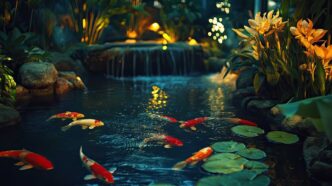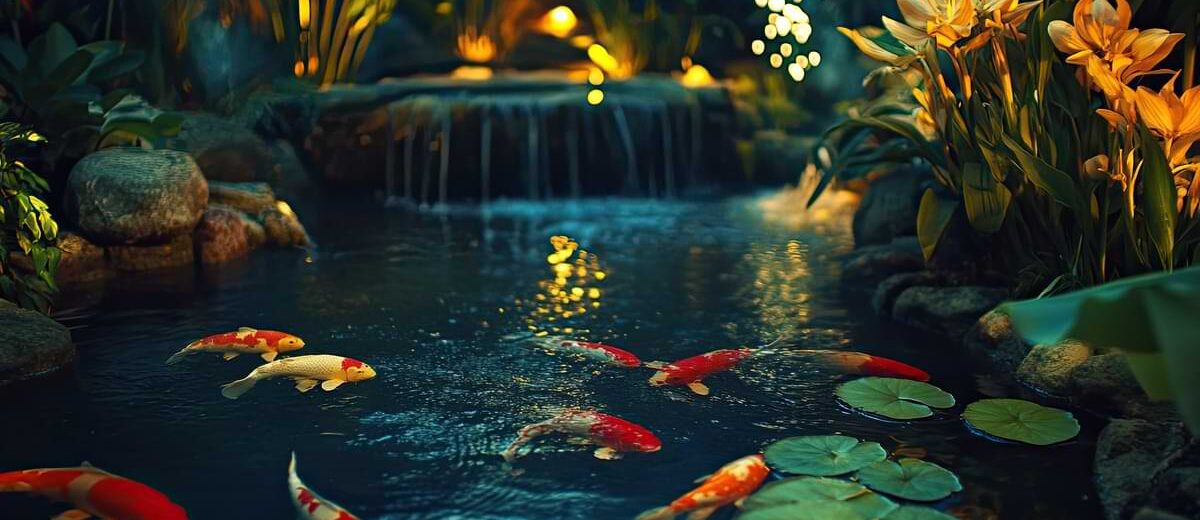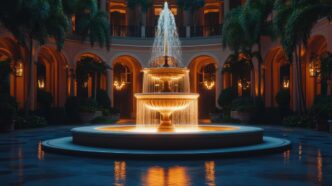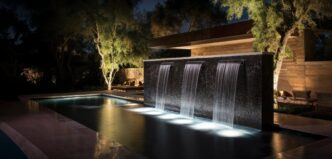Table of Contents: Pond Lighting Guide
- Pond Lighting 101
- The Benefits of Fish-Friendly Pond Lighting
- Create Fish-Friendly Pond Lighting in 5 Steps
- FAQs for Pond Lighting
Pond Lighting 101
Pond lighting can completely transform a backyard, bringing movement, reflection, and a sense of calm to your outdoor space. At night, it adds an entirely new dimension: rippling water glows, garden features shine, and the whole area feels like a serene retreat.
But when your pond is home to fish, not every lighting choice is a good one. Let’s dive into the best way to create safe, fish-friendly pond lighting.
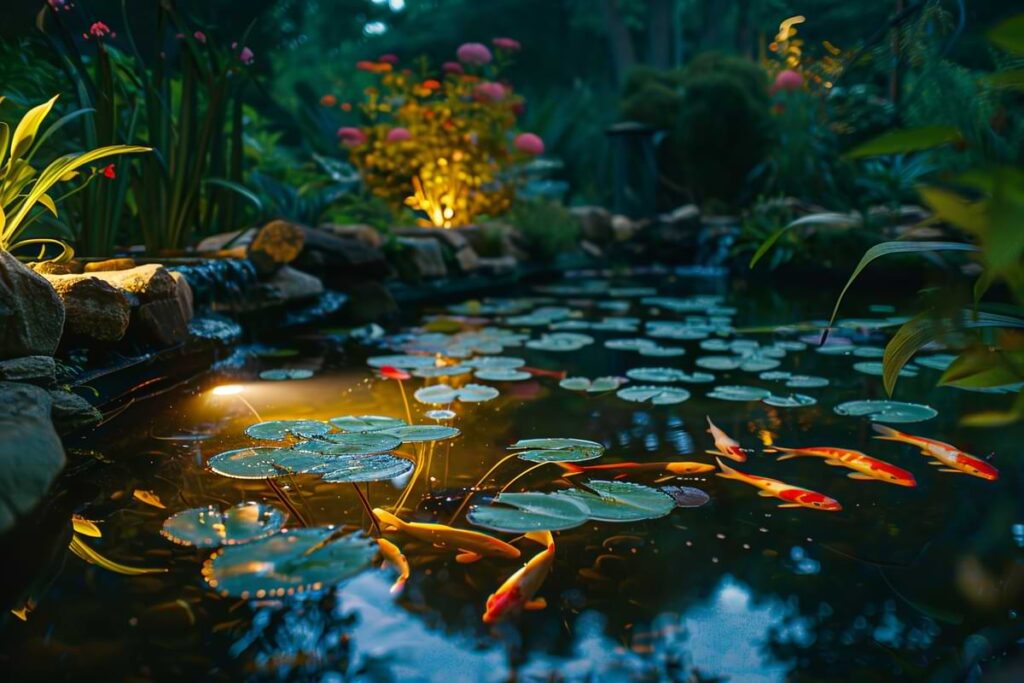
The Benefits of Fish-Friendly Pond Lighting
Excessive or poorly placed light can stress fish and disrupt their natural rhythms. By understanding the advantages of fish-friendly lighting, you can design a pond that’s both beautiful and safe for its aquatic residents.
- Support Fish Health: Fish need natural light-and-dark cycles. Gentle, well-placed lighting keeps them healthy without causing stress. For example, positioning lights behind rocks or plants gives fish shaded areas to retreat to at night.
- Enhance Aesthetics: Layered, subtle lights highlight plants, water, and movement without harsh glare, creating a natural, moonlit effect. For instance, if you uplight a small tree near your pond, you can achieve a soft, dreamy reflection of the light and the shadow of the tree rippling on the surface, adding depth and texture.
- Save Energy and Protect the Ecosystem: Efficient LEDs use less power, produce minimal heat, and help maintain a balanced pond environment. An example is using low-voltage LED submersible lights to illuminate a waterfall without raising water temperature.
Create Fish-Friendly Pond Lighting in 5 Steps
Creating pond lighting that’s safe for fish means balancing beauty with the needs of aquatic life. Thoughtful placement, gentle illumination, and proper timing help your pond shine without stressing its residents.
With the basics in mind, here are five practical tips to help you design fish-friendly pond lighting that enhances your landscape while protecting your aquatic life.
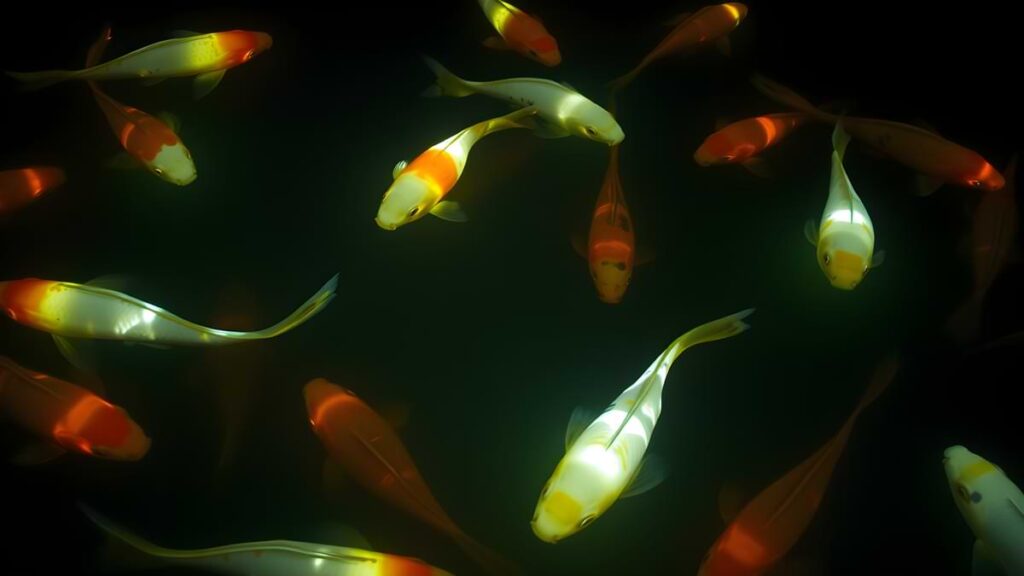
1: Choose the Right Color Temperature
Stick with warm white LEDs (2700K–3000K) for a natural glow. Cooler lights can mimic daylight, confusing fish and altering their behavior when used at night. By using lights with warm tones, you can also bring out the natural colors of plants, rocks, and fish without creating harsh reflections.
For example, a subtle amber light can highlight a waterfall while keeping the pond surface calm and inviting.
2: Use Submersible Lights Carefully
When installing underwater fixtures, angle them toward rocks, waterfalls, or plants instead of directly at fish. This provides dramatic beauty while leaving shaded areas for retreat.
You can also cluster a few low-intensity lights around the pond’s edge to create depth and shimmer without overwhelming the fish. Floating solar lights or recessed lighting in decorative pots are additional ways to illuminate water safely.
3: Layer Your Lighting
Combine soft underwater lights with uplighting on nearby plants or downlighting from surrounding trees. This approach reduces reliance on bright underwater lights while enhancing the overall scene.
For example, an accent light on a tall ornamental grass or tree branch can create a natural reflection on the water, adding texture and dimension without disturbing the pond’s residents.
4: Limit Lighting Duration
Set pond lights on a timer to run for two to four hours in the evening. This creates a peaceful nighttime display while preserving the natural dark cycle fish need to rest.
Consider turning off underwater lights when not in use, or using motion-activated fixtures along pathways to avoid unnecessary exposure and maintain the pond’s nighttime environment.
5: Prioritize Safety and Efficiency
LEDs are best for pond lighting, as they last longer, use less power, and won’t heat up the water. A safe, low-voltage setup is essential for protecting both your fish and your landscape.
Waterproof connectors and properly grounded transformers help prevent accidents, and using energy-efficient LEDs reduces the risk of overheating delicate aquatic plants or algae blooms.
FAQs for Pond Lighting
To light a pond, combine underwater lights with surrounding landscape fixtures. Use submersible LEDs for highlights, uplighting on plants or rocks for depth, and timers to control duration.
LED submersible lights are the best choice because they’re energy-efficient, long-lasting, and safe for water use. Low-voltage and warm white fixtures provide soft, natural-looking illumination.
Use warm white LEDs (2700K–3000K), avoid aiming lights directly at fish, and run them only a few hours each night. Layer lighting with nearby plants or downlighting to reduce underwater glare and give fish shaded areas to retreat.
Join our Insider list and check out the different lighting options that we have to offer.
